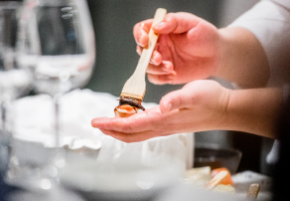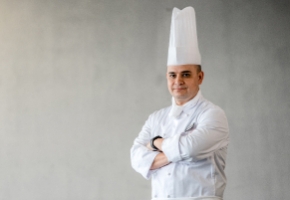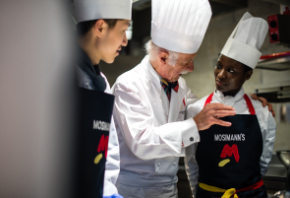- About
- Programs
- Campus Life
- Career Services
- Admissions
- News & Events
- Alumni
What Is Saffron? Origin, Uses & Health Benefits
Discover what saffron is, where it comes from, and its uses. Learn why it's so valuable—read our guide before you buy or cook with it.
Key Takeaways
- Saffron comes from the dried stigmas of the Crocus sativus flower and is prized for its rich color, aroma, and labor-intensive harvesting process.
- Saffron is widely used in Middle Eastern, Indian, and Mediterranean cuisines and also valued in traditional medicine and modern supplements for its potential health benefits.
- Due to its high cost and frequent counterfeiting, learning how to identify, store, and cook with real saffron is essential for both home cooks and culinary students.
Few ingredients hold the kind of mystique that saffron does. Known for its vivid hue and unmistakable aroma, this vibrant spice has long been associated with richness, both in flavor and value. Often topping the list as the world's most expensive spice, saffron sparks curiosity in chefs, food lovers, and health enthusiasts alike.
Just one kilogram of saffron can cost between €2,840 and €3,999 in Europe. In the U.S., the same amount can cost up to $3,670. The price itself and its presence in a dish hint at something special, something rare.
For chefs and culinary enthusiasts, knowing what saffron is and how it can be used in the kitchen and beyond is part of appreciating its true value.
What Is Saffron?
Saffron is a spice made from the dried stigmas of the Crocus sativus flower, a small purple bloom that produces only three red threads per blossom. These delicate strands are carefully handpicked during a short harvesting season, often at dawn when the flowers are fully open. The process is slow, precise, and incredibly labor-intensive, which adds to saffron’s rarity and high value.
The threads themselves are a deep red color and release a golden hue when steeped in liquid. Saffron offers a slightly sweet, earthy flavor and a warm, hay-like aroma that’s both subtle and distinctive. A pinch can transform the color, scent, and taste of an entire dish, making it a favorite in cuisines that value richness and depth.
Where does saffron come from?
Today, saffron is mainly cultivated in Iran, India’s Kashmir region, Spain, and Greece. As of the latest statistics from 2022, Iran alone produces 80% of the world’s supply, while Kashmir, Spain, and Greece maintain smaller yet celebrated harvests, quality-controlled by regional designations such as Greece’s PDO label (Protected Designation of Origin).
Start Your Culinary Journey
Learn the art of cooking in a world-class environment
Producing saffron in itself is an intricate process that requires the human touch. That’s because the Crocus sativus flower seeds are sterile, which impacts natural pollination. To create new saffron plants, farmers take parts of the parent plant—specifically, the underground part called a corm (similar to a bulb)—and replant it.
The flowers bloom for only a few weeks; therefore, the timing of the harvest is very important. Farmers must pick the blossoms early in the morning, often before sunrise, to prevent the petals from wilting and to keep the fragile red stigmas intact.
Traditionally, this work has been done entirely by hand, while modern farms now incorporate hydroponics, controlled drying chambers, and greenhouse methods to boost efficiency and consistency.
How Is Saffron Made?
Once harvested, the flowers are taken to be processed by hand. The red stigmas (the thread-like red parts at the center) are gently separated from the rest of the flower. This step, known as "stripping," must be done by hand to avoid tearing or bruising the threads. Each flower contains only three stigmas, which adds to the challenge.
Once separated, the stigmas are dried to preserve their flavor, color, and aroma. Traditional methods use gentle heat or natural sunlight, while some producers use controlled drying environments for consistency. The dried stigmas are then stored in a dark, dry location.
Saffron’s high price comes from the intense labor required and the enormous number of flowers needed—around 110,000-117,000 flowers to yield just one kilogram of saffron. In addition, every step, from harvesting to drying, must be done by hand, making it one of the most labor-intensive spices in the world.
Fun Facts About Saffron
Saffron shines not only in flavor and aroma but also in fascinating stories and surprising benefits. These fun facts offer insight into why this spice continues to captivate chefs, history lovers, and wellness seekers alike.
- Saffron is often called “red gold.” Its bright red threads give food a shiny golden hue, and due to the labor-intensive harvesting process, saffron is one of the priciest spices in the world.
- Ancient Persians used saffron in perfumes and royal dyes. For millennia, Persian royalty adorned clothing and sacred spaces with saffron’s scent and hue.
- Cleopatra is said to have bathed in saffron-infused milk, using it to enhance her skin’s glow and allure. Historical accounts suggest she also used saffron in her beauty products.
- Saffron has been prized for over 3,000 years. From ancient Mesopotamia and Egypt to Greece and Rome, saffron has appeared in art, medicine, and ritual.
Culinary Uses of Saffron
Saffron has found its way into kitchens across continents, lending both color and complexity to a wide range of dishes. Its unmistakable golden hue and earthy-sweet flavor make it a treasured ingredient in many culinary traditions.
This spice is popular in many international cuisines, especially in Middle Eastern, Indian, and Mediterranean cuisine:
- In Spain, it gives paella its signature aroma and golden tint.
- In India, saffron is added to biryani for a rich depth of flavor and an elegant presentation.
- In Iran and other parts of the Middle East, it’s often used to infuse desserts like saffron rice pudding or syrups poured over cakes.
Saffron also appears in herbal teas and milk-based drinks, where its subtle fragrance enhances each sip. Given its potency, even a small amount goes a long way, necessitating proper use. This means understanding its strength, as well as how to pair it with other spices and ingredients to achieve flavor balance.
At Culinary Arts Academy Switzerland (CAAS), students are trained to appreciate these nuances. They learn how to work with global spices, including saffron, as they study flavor layering, ingredient sourcing, and creative plating. The goal is to develop chefs who understand technique along with the cultural and culinary roots of what they serve.
Health Benefits of Saffron
Saffron has been valued for centuries in traditional systems of medicine, including Persian, Ayurvedic, and Chinese practices. It has long been used to support digestion, uplift mood, and relieve symptoms associated with PMS. While historical uses were mostly based on experience and observation, modern research is increasingly exploring the science behind these claims.
Today, saffron extract appears in many herbal supplements, praised for both its natural origin and potential benefits. One of the most studied areas is mood support. Clinical trials have shown that saffron may help reduce symptoms of mild-to-moderate depression and anxiety. In several head-to-head comparisons, it performed similarly to prescription antidepressants like fluoxetine and imipramine, but with fewer reported side effects.
Saffron is also rich in antioxidants, particularly crocin, crocetin, and safranal, which help protect cells from oxidative stress. These compounds are being studied for their anti-inflammatory effects and their ability to support heart and brain health.
Some early findings suggest saffron may also help maintain eye health and slow down age-related vision decline, such as in macular degeneration (PubMed).
Other potential benefits include reducing PMS symptoms, improving sleep, and supporting weight management by curbing appetite. While saffron supplements are available in many forms (from capsules to teas), it’s important to choose reputable sources and consult a healthcare provider before use, especially for ongoing concerns or existing conditions.
How to Identify Real Saffron
With saffron’s high price and growing demand, counterfeit versions have flooded the market, often made from dyed corn silk, safflower, or shredded paper. These versions often mimic the look but lack the signature aroma, taste, and color release of the real spice.
Therefore, learning how to tell the difference ensures you're getting authentic saffron and not a cheap substitute. Here are some key tips to spot real saffron:
- Color: Real saffron threads are deep red with orange tips. They are not perfectly uniform in size or color.
- Shape: Authentic threads have a trumpet-like shape at one end. Fake saffron may appear flat or string-like.
- Smell: Genuine saffron has an earthy, hay-like aroma with slightly sweet undertones.
- Taste: When chewed, real saffron tastes slightly bitter, not sweet or sugary.
- Water test: Soak a few threads in warm water or milk. Real saffron releases a golden yellow color gradually over 10–15 minutes, not instantly.
- Price: High-quality saffron is never cheap. If the price seems too good to be true, it likely is a substitute.
How to Use Saffron in Cooking
While it’s true that saffron’s intense flavor and vibrant color can transform a dish, it’s also important to know how to use it correctly. This prized spice needs careful handling to bring out its full aroma and richness without overpowering other ingredients.
Before adding saffron to your recipe, soak the threads in a small amount of warm water, broth, or milk for about 10 to 15 minutes. This helps release the color and flavor more evenly into your dish. The liquid, along with the threads, can then be stirred into rice, stews, soups, or desserts.
Be careful with the amount of saffron used in your cooking. Usually, a small pinch (about 5 to 10 threads) is enough for a recipe serving four to six people. Adding too much can create a bitter taste.
To preserve its potency, saffron should be stored in an airtight container, away from light and heat. Glass jars kept in a cool, dark place work well. Avoid exposure to humidity or strong odors, which can affect the spice’s quality over time. When stored properly, saffron can retain its flavor for up to two years.
Spice Up Your Cooking With Saffron
Saffron brings color, depth, and elegance to both cooking and wellness traditions. Known for its warm aroma and delicate flavor, it is often featured in rice dishes, desserts, teas, and herbal remedies. Its presence in kitchens around the world reflects a deep appreciation for quality and craftsmanship.
At CAAS, students learn how to use saffron and explore its full creative potential. Through hands-on training and expert guidance, they experiment with new flavor combinations, push boundaries, and discover inventive applications for fine ingredients. If you want to develop your skills and understand the art—and science—of flavor, explore our programs and begin your journey into the world of professional culinary arts.
Frequently Asked Questions
Why is saffron so expensive?
Saffron is costly because it must be harvested by hand, and it takes over 100,000 flowers to produce one pound of dried saffron.
Can I grow saffron at home?
Yes, you can grow saffron at home in well-drained soil with plenty of sunlight, typically from corms planted in late summer.
Is saffron safe to consume daily?
Saffron is generally safe in small amounts, but high doses may cause side effects, so moderation is important
Interested in becoming a world-class chef? Learn more about Culinary Arts Academy Switzerland. Download our brochure.
























